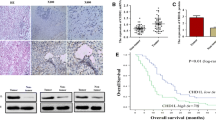Abstract
Background
Chromodomain helicase/ATPase DNA binding protein 1-like gene (CHD1L) is involved in malignancies. However, the role of CHD1L in gastric cancer (GC) has not been elucidated. The aim of this study is to explore the clinical role of CHD1L in GC.
Methods
The gene and protein expression levels of CHD1L were detected by quantitative real-time PCR and Western blot analysis in fresh samples of GC and paired adjacent noncancerous tissue (n = 34). We evaluated the CHD1L expression by immunohistochemistry in a large number of GC patients (n = 616) and paired adjacent noncancerous tissues from December 1, 2004 to December 1, 2008. The correlations of CHD1L expression with clinicopathological features and clinical outcome were analyzed.
Results
The gene and protein expression levels of CHD1L were higher in fresh samples of GC than in paired adjacent noncancerous tissues as determined by quantitative real-time PCR and Western blot analysis. Immunohistochemical analysis showed that positive expression rates of CHD1L in GC and paired adjacent noncancerous tissues were 58.7 % (361/616) and 7.3 % (45/616), respectively. CHD1L positivity was significantly associated with clinical stage and distant metastasis. GC patients with positive CHD1L expression had shorter overall survival than those with negative CHD1L expression. Multivariate analysis showed that CHD1L was an independent prognostic marker for overall survival [Hazard Ratio (HR) = 5.952, 95 % confidence interval (CI) = 3.194–11.187, P = 0.0043].
Conclusion
These results indicated that CHD1L could serve as a prognostic marker for GC.




Similar content being viewed by others
References
Liang JW, Gao P, Wang ZN, Song YX, Xu YY, Wang MX, et al. The integration of macroscopic tumor invasion of adjacent organs into TNM staging system for gastric cancer. PLoS One. 2012;7:e52269.
Jemal A, Bray F, Center MM, Ferlay J, Ward E, Forman D. Global cancer statistics. CA Cancer J Clin. 2011;61:69–90.
Sun J, Jiang T, Qiu Z, Cen G, Cao J, Huang K, et al. Short-term and medium-term clinical outcomes of laparoscopic-assisted and open surgery for gastric cancer: a single center retrospective case-control study. BMC Gastroenterol. 2011;11:85.
Popa F, Bratucu M, Radu P. Present and future tense in operable rectal cancer. Chirurgia (Bucur). 2011;106:11–6.
Isinger-Ekstrand A, Johansson J, Ohlsson M, Francis P, Staaf J, Jönsson M, et al. Genetic profiles of gastroesophageal cancer: combined analysis using expression array and tiling array–comparative genomic hybridization. Cancer Genet Cytogenet. 2010;200:120–6.
Gottschalk AJ, Timinszky G, Kong SE, Jin J, Cai Y, Swanson SK, et al. Poly(ADP-ribosyl)ation directs recruitment and activation of an ATP-dependent chromatin remodeler. Proc Natl Acad Sci USA. 2009;106:13770–4.
Kokavec J, Podskocova J, Zavadil J, Stopka T. Chromatin remodeling and SWI/SNF2 factors in human disease. Front Biosci. 2008;13:6126–34.
Ma NF, Hu L, Fung JM, Xie D, Zheng BJ, Chen L, et al. Isolation and characterization of a novel oncogene, amplified in liver cancer 1, within a commonly amplified region at 1q21 in hepatocellular carcinoma. Hepatology. 2008;47:503–10.
Chen L, Chan TH, Yuan YF, Hu L, Huang J, Ma S, et al. CHD1L promotes hepatocellular carcinoma progression and metastasis in mice and is associated with these processes in human patients. J Clin Invest. 2010;120:1178–91.
Chen L, Yuan YF, Li Y, Chan TH, Zheng BJ, Huang J, et al. Clinical significance of CHD1L in hepatocellular carcinoma and therapeutic potentials of virus-mediated CHD1L depletion. Gut. 2011;60:534–43.
Hartgrink HH, Jansen EP, van Grieken NC, van de Velde CJ. Gastric cancer. Lancet. 2009;374:477–90.
Wong N, Chan A, Lee SW, Lam E, To KF, Lai PB, et al. Positional mapping for amplified DNA sequences on 1q21-q22 in hepatocellular carcinoma indicates candidate genes over-expression. J Hepatol. 2003;38:298–306.
Hyeon J, Ahn S, Park CK. CHD1L is a marker for poor prognosis of hepatocellular carcinoma after surgical resection. Korean J Pathol. 2013;47:9–15.
He WP, Zhou J, Cai MY, Xiao XS, Liao YJ, Kung HF, et al. CHD1L protein is overexpressed in human ovarian carcinomas and is a novel predictive biomarker for patients survival. BMC Cancer. 2012;12:437.
Conflict of interest
None.
Author information
Authors and Affiliations
Corresponding author
Rights and permissions
About this article
Cite this article
Su, Z., Zhao, J., Xian, G. et al. CHD1L is a novel independent prognostic factor for gastric cancer. Clin Transl Oncol 16, 702–707 (2014). https://doi.org/10.1007/s12094-013-1136-8
Received:
Accepted:
Published:
Issue Date:
DOI: https://doi.org/10.1007/s12094-013-1136-8




